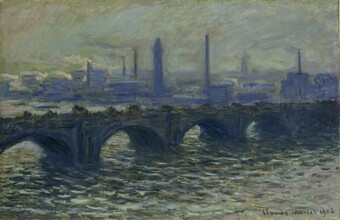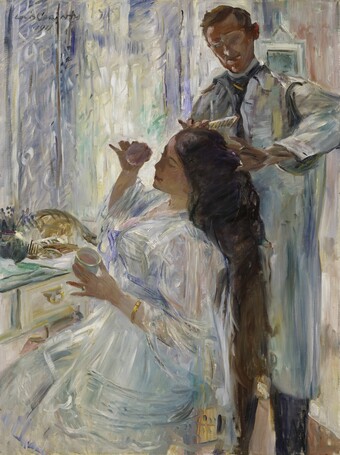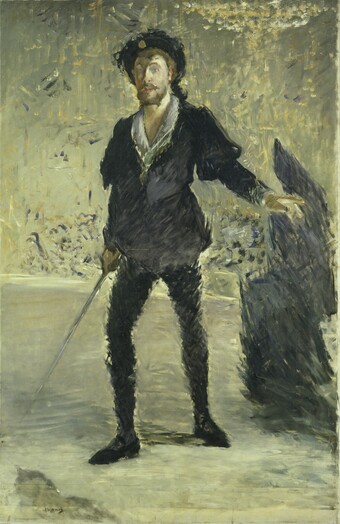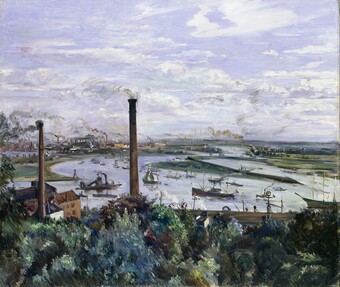IMPRESSIONISM
Press information
Franco-German Encounters
A fresh look at the collection
The tour through the permanent collection will continue to be updated in the coming years
With a new presentation of over 70 works by French and German Impressionists, the Hamburger Kunsthalle is taking a fresh look at one of the defining art move¬ments of modernism as a European phenomenon.
Curators
Dr Markus Bertsch (Head of the Nineteenth-Century Collection) and Dr Karin Schick (Head of the Classical Modernism Collection)
Research Assistants
Jasper Warzecha and Selvi Göktepe
Paintings and sculptures are presented in new constellations in five redesigned halls in the Licht¬wark Gallery. Major works by Max Liebermann, Lovis Corinth and Max Slevogt, the »triumvirate of German Impressionism«, meet up here with French icons such as Édouard Manet, Auguste Renoir and Claude Monet. The show also brings in artists who have not been presented at the Hamburger Kunsthalle for a long time, featuring paintings by Alma del Banco, Paul Baum, Ivo Hauptmann, Maximilien Luce, Henri Martin and Lesser Ury. Accompanying the paintings are a number of sculptures– for example by Edgar Degas. Impressionism: Franco-German Encounters is one of a series of new installations in the Hamburger Kunsthalle’s collection tour through eight centuries of art history that explore original new questions and present the collection in a fresh light.
To retell the story of Impressionism, exhibits are deliberately juxtaposed to illustrate how impulses emanating from France were taken up and productively developed in Germany: Claude Monet’s Waterloo Bridge (1902) thus appears in dialogue with Lovis Corinth’s View of the Kohlbrand (1911), Pierre Bonnard’s Lantern Procession on the Outer Alster (1913) meets up with Evening at Uhlenhorst Ferry (1910) by Max Liebermann, and Édouard Manet’s Jean-Baptiste Faure in the Opera »Hamlet« (1875/77) is shown side-by-side with The Black d’Andrade (1903) by Max Slevogt. The chapters »Portrait«, »Landscape«, »Staged Figure«, »City and Leisure« and »Still Life« illustrate the themes and motifs addressed by painters on both sides of the Rhine, inquiring into their sources of inspiration and which mutual influences can be traced visually and historically.
Impressionism emerged in France from the 1870s onward but began to wane in significance with the outbreak of the Second World War. In Germany, by contrast, Impressionist tendencies remained significant until well into the 1920s. Around the turn of the century, several German museum directors made a concerted effort to promote Impressionism through exhibitions and acquisitions. In Hamburg, for example, it is thanks to major German and French acquisitions by Alfred Lichtwark (1852–1914) and Gustav Pauli (1866–1938) that the Kunsthalle today possesses one of the most important collections of Impressionist painting in Germany.
The show however looks further to the advent of classical modernism in order to examine to what extent Impressionism remained relevant for the following generation. Max Beckmann, Emil Nolde and the artists’ group »Die Brücke« as well as the members of the Hamburg Secession all went through Impressionist phases, at least in their early works.
A richly illustrated catalogue (Wienand Verlag, 25 euros) presents the main Impressionist works in the collection in new and different constellations while introducing the various chapters in the presentation and explaining the historical background in a number of essays. Educational offerings to complement the presentation include a multimedia guide (also suitable for children aged 8 and over) in the Hamburger Kunsthalle app (German/English) and an activity booklet designed for families with children aged 5 in both analogue and digital form.
The project Impressionism: Franco-German Encounters is part of the plan to recast the different areas of the collection. Also redesigned is the Makart Hall, presenting the show MAKING HISTORY: Hans Makart and the Salon Painting of the 19th Century, the sculpture presentation ON HYBRID CREATURES: SCULPTURE IN MODERNISM and the area of Contemporary Art with the presentation something new, something old, something desired. The recast of the area of Classical Modernism is scheduled for 2023, the Old Masters are scheduled for 2024. The Hamburger Kunsthalle collection is one of the most important in Northern Europe. By retelling its many stories, the museum is endeavouring to present its treasures to the public in novel contexts and from diverse perspectives.
Download Press Release

Die Waterloo-Brücke, 1902
Öl auf Leinwand
65 x 100 cm
© Hamburger Kunsthalle / bpk Foto: Elke Walford
Diese Pressebilder stehen in druckfähiger Qualität im Online-Presseservice unter www.hamburger-kunsthalle.de zum Download bereit. Veröffentlichung nur gestattet im Zusammenhang mit einer aktuellen redaktionellen Berichterstattung über die Ausstellung in der Hamburger Kunsthalle. Jede andere Nutzung ist nicht gestattet. Die Bilder dürfen nicht angeschnitten und/oder mit Schrift überschrieben werden.
Publication only allowed in connection with editorial reports of the exhibition. Any other use is not allowed. The photos should not be cropped or overwritten with any form of text.

© Veröffentlichung nur gestattet im Zusammenhang mit einer redaktionellen Berichterstattung über die Präsentation in der Hamburger Kunsthalle. Jede andere Nutzung ist nicht gestattet. Die Bilder dürfen nicht angeschnitten und/oder mit Schrift über-schrieben werden. © Publication only allowed in connection with editorial reports on the presentation at Hamburger Kunsthalle. Any other use is not allowed. The photos should not be cropped or overwritten with any form of text.

Charlotte Corinth am Frisiertisch, 1911
Öl auf Leinwand
120 x 90 cm
© Hamburger Kunsthalle / bpk Foto: Elke Walford
Diese Pressebilder stehen in druckfähiger Qualität im Online-Presseservice unter www.hamburger-kunsthalle.de zum Download bereit. Veröffentlichung nur gestattet im Zusammenhang mit einer aktuellen redaktionellen Berichterstattung über die Ausstellung in der Hamburger Kunsthalle. Jede andere Nutzung ist nicht gestattet. Die Bilder dürfen nicht angeschnitten und/oder mit Schrift überschrieben werden.
Publication only allowed in connection with editorial reports of the exhibition. Any other use is not allowed. The photos should not be cropped or overwritten with any form of text.

Der schwarze d’Andrade, 1903
Öl auf Leinwand
150 x 109 cm
© Hamburger Kunsthalle / bpk Foto: Elke Walford
Diese Pressebilder stehen in druckfähiger Qualität im Online-Presseservice unter www.hamburger-kunsthalle.de zum Download bereit. Veröffentlichung nur gestattet im Zusammenhang mit einer aktuellen redaktionellen Berichterstattung über die Ausstellung in der Hamburger Kunsthalle. Jede andere Nutzung ist nicht gestattet. Die Bilder dürfen nicht angeschnitten und/oder mit Schrift überschrieben werden.
Publication only allowed in connection with editorial reports of the exhibition. Any other use is not allowed. The photos should not be cropped or overwritten with any form of text.

Jean-Baptiste Faure in der Oper "Hamlet" von Ambroise Thomas, 1875/77
Öl auf Leinwand
196 x 129 cm
© Hamburger Kunsthalle/bpk Foto: Elke Walford
Diese Pressebilder stehen in druckfähiger Qualität im Online-Presseservice unter www.hamburger-kunsthalle.de zum Download bereit. Veröffentlichung nur gestattet im Zusammenhang mit einer aktuellen redaktionellen Berichterstattung über die Ausstellung in der Hamburger Kunsthalle. Jede andere Nutzung ist nicht gestattet. Die Bilder dürfen nicht angeschnitten und/oder mit Schrift überschrieben werden.
Publication only allowed in connection with editorial reports of the exhibition. Any other use is not allowed. The photos should not be cropped or overwritten with any form of text.
Abend am Uhlenhorster Fährhaus, 1910
Öl auf Leinwand
77 x 96 cm
© Hamburger Kunsthalle / bpk Foto: Elke Walford
Diese Pressebilder stehen in druckfähiger Qualität im Online-Presseservice unter www.hamburger-kunsthalle.de zum Download bereit. Veröffentlichung nur gestattet im Zusammenhang mit einer aktuellen redaktionellen Berichterstattung über die Ausstellung in der Hamburger Kunsthalle. Jede andere Nutzung ist nicht gestattet. Die Bilder dürfen nicht angeschnitten und/oder mit Schrift überschrieben werden.
Publication only allowed in connection with editorial reports of the exhibition. Any other use is not allowed. The photos should not be cropped or overwritten with any form of text.

Große Arabeske, Zweite Position, 1882/95
Ausführung in Bronze: frühestens 1920 bis spätestens 1926 Bronze
43 x 28 x 61 cm
© Hamburger Kunsthalle / bpk Foto: Elke Walford
Diese Pressebilder stehen in druckfähiger Qualität im Online-Presseservice unter www.hamburger-kunsthalle.de zum Download bereit. Veröffentlichung nur gestattet im Zusammenhang mit einer aktuellen redaktionellen Berichterstattung über die Ausstellung in der Hamburger Kunsthalle. Jede andere Nutzung ist nicht gestattet. Die Bilder dürfen nicht angeschnitten und/oder mit Schrift überschrieben werden.
Publication only allowed in connection with editorial reports of the exhibition. Any other use is not allowed. The photos should not be cropped or overwritten with any form of text.

Lampionkorso auf der Außenalster, 1913
Öl auf Leinwand
37,5 x 47,5 cm
© Hamburger Kunsthalle / bpk Foto: Elke Walford
Diese Pressebilder stehen in druckfähiger Qualität im Online-Presseservice unter www.hamburger-kunsthalle.de zum Download bereit. Veröffentlichung nur gestattet im Zusammenhang mit einer aktuellen redaktionellen Berichterstattung über die Ausstellung in der Hamburger Kunsthalle. Jede andere Nutzung ist nicht gestattet. Die Bilder dürfen nicht angeschnitten und/oder mit Schrift überschrieben werden.
Publication only allowed in connection with editorial reports of the exhibition. Any other use is not allowed. The photos should not be cropped or overwritten with any form of text.

Blick auf den Köhlbrand, 1911
Öl auf Leinwand
114,5 x 135 cm
© Hamburger Kunsthalle / bpk Foto: Elke Walford
Diese Pressebilder stehen in druckfähiger Qualität im Online-Presseservice unter www.hamburger-kunsthalle.de zum Download bereit. Veröffentlichung nur gestattet im Zusammenhang mit einer aktuellen redaktionellen Berichterstattung über die Ausstellung in der Hamburger Kunsthalle. Jede andere Nutzung ist nicht gestattet. Die Bilder dürfen nicht angeschnitten und/oder mit Schrift überschrieben werden.
Publication only allowed in connection with editorial reports of the exhibition. Any other use is not allowed. The photos should not be cropped or overwritten with any form of text.
